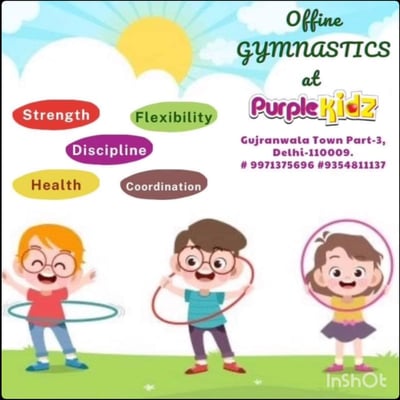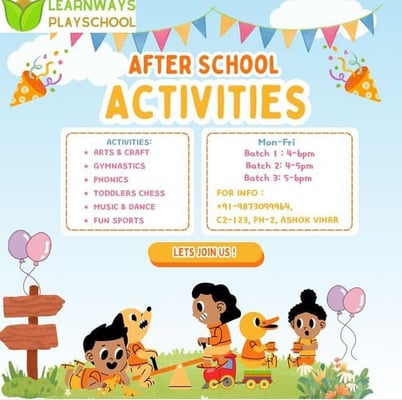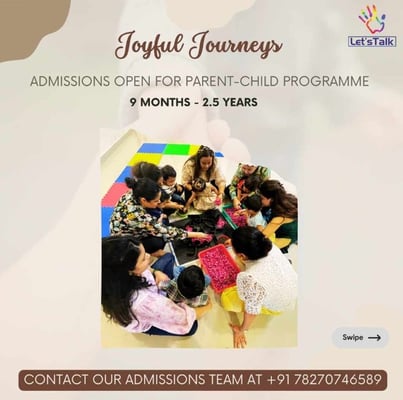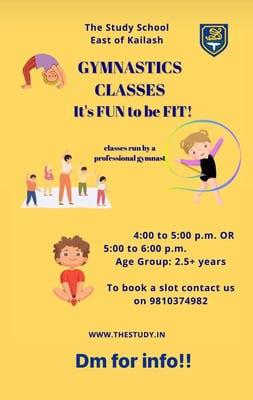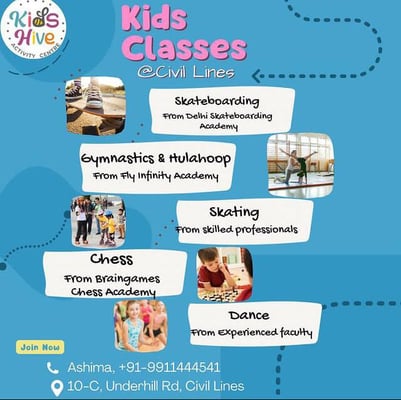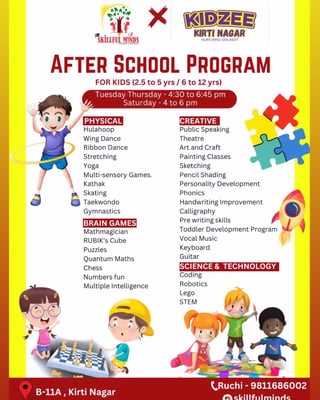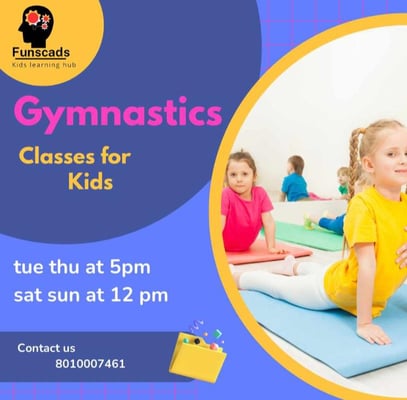Gymnastics classes for Kids - 33 options found
Gymnastics classes for children aged 2 to 15 offer numerous ... Gymnastics classes for children aged 2 to 15 offer numerous benefits, including physical fitness, motor skill development, cognitive stimulation, socialization, discipline, and personal growth. Through structured training and practice, children improve their cardiovascular health, strength, coordination, and flexibility while enhancing their cognitive abilities and social skills. Gymnastics fosters confidence, teamwork, and perseverance as children set and achieve goals, overcome challenges, and express themselves creatively through routines and performances. Participation in gymnastics classes promotes holistic development and instills lifelong fitness habits, empowering children to thrive both physically and mentally. Read more
purplekidz-dance classes by tanya
purple kidz - gymnastics
learn ways play school-after school activities
lets talk-admission open for parent-child programme
learnways playschool-gymnastics fitness class
amozish-gymnastics
purplekidz-day care
final round fight club-sports classes
purplekidz-offline classes
bluzenbubs pre-school-evening classes
the study school-gymnastics classes
kids hive-kids classes
learnways playschool-gymnastics classes
amozish-dance+gymnastics
dance house delhi-dance house
skillful minds-after-school program for kids
funscads-gymnastics classes for kids
little millennium-session break program
Advantages of Gymnastics Classes for Children Ages 2 to 15
Introduction
Gymnastics classes offer children aged 2 to 15 an opportunity to develop physical fitness, coordination, flexibility, and strength through structured gymnastics training. These classes provide numerous benefits, including physical health, motor skill development, socialization, and personal growth. In this guide, we will explore the advantages of gymnastics classes for children in this age range, along with addressing potential limitations and common questions.
Advantages
-
Physical Fitness:
- Cardiovascular Health: Gymnastics classes promote cardiovascular fitness through activities such as running, jumping, and tumbling, improving heart health and endurance.
- Muscle Strength: Gymnastics exercises strengthen major muscle groups, including the core, arms, legs, and back, enhancing overall muscular strength and endurance.
- Flexibility and Range of Motion: Stretching exercises and flexibility drills in gymnastics classes increase flexibility and range of motion, reducing the risk of injury and improving posture.
-
Motor Skill Development:
- Coordination: Gymnastics activities require precise coordination of movements, improving gross motor skills such as balance, agility, and spatial awareness.
- Balance and Stability: Balancing exercises on beams and bars enhance proprioception and balance, improving stability and coordination in children.
- Fine Motor Skills: Grip strength, hand-eye coordination, and dexterity are developed through activities such as gripping bars, swinging on rings, and performing handstands.
-
Cognitive Benefits:
- Brain Development: Gymnastics classes stimulate brain development by promoting neural connections through complex movements and spatial awareness tasks.
- Problem-Solving Skills: Learning new gymnastics routines and mastering challenging skills fosters problem-solving abilities and cognitive flexibility as children overcome obstacles and refine their techniques.
- Focus and Concentration: Gymnastics requires focused attention and concentration during training and performances, enhancing cognitive skills such as attention span and concentration.
-
Socialization and Teamwork:
- Peer Interaction: Gymnastics classes provide opportunities for children to interact with peers, fostering social skills such as cooperation, communication, and teamwork.
- Supportive Environment: Gymnastics fosters a supportive and inclusive environment where children encourage and motivate each other, building camaraderie and friendships.
- Confidence and Self-Esteem: Achieving new skills and overcoming challenges in gymnastics classes boost children's confidence and self-esteem, empowering them to set and achieve goals.
-
Discipline and Determination:
- Work Ethic: Gymnastics instills discipline and determination as children adhere to training schedules, follow instructions, and practice consistently to improve their skills.
- Resilience: Facing setbacks and challenges in gymnastics classes teaches children resilience and perseverance as they learn to overcome obstacles and setbacks through effort and determination.
-
Personal Growth:
- Goal Setting: Gymnastics encourages goal setting and achievement as children strive to master new skills, improve their performance, and progress through levels of difficulty.
- Self-Expression: Gymnastics routines and performances allow children to express themselves creatively and artistically, fostering self-expression and individuality.
Limitations
-
Risk of Injury:
- Safety Concerns: Gymnastics involves high-impact movements and stunts that may pose a risk of injury, particularly if proper technique and supervision are lacking. Coaches must prioritize safety and implement appropriate spotting techniques and equipment to reduce injury risk.
-
Intensity and Pressure:
- Physical Demands: Intensive gymnastics training can be physically demanding, placing stress on the body and increasing the risk of overuse injuries or burnout, particularly for young athletes.
- Performance Pressure: Competitive gymnastics environments may create pressure to perform at a high level, leading to stress, anxiety, or psychological strain in some children.
-
Financial and Time Commitment:
- Cost: Participation in gymnastics classes or competitive programs may involve significant financial expenses for training, equipment, uniforms, and competition fees.
- Time Commitment: Gymnastics training requires a considerable time commitment for regular practices, competitions, and travel, which may conflict with other interests or activities.
Common Questions
-
At What Age Should Children Start Gymnastics Classes?
- Children can start gymnastics classes as early as preschool age, typically around 2 or 3 years old, with age-appropriate activities and instruction tailored to their developmental stage. Many gymnastics programs offer parent-child classes for toddlers to introduce basic movement skills and coordination exercises.
-
How Can Parents Support Their Children's Participation in Gymnastics?
- Parents can support their children's participation in gymnastics by providing encouragement, attending practices and competitions, and promoting a healthy balance between training and other activities. Parents should also ensure that their children have access to proper nutrition, rest, and medical care to support their physical and mental well-being.
-
What Career Opportunities Are Available for Gymnasts?
- Gymnasts who excel in the sport may pursue opportunities in competitive gymnastics, coaching, judging, or performing in entertainment productions such as circuses or shows. Some gymnasts may also transition to careers in sports medicine, physical therapy, or fitness instruction.
-
Is Gymnastics Only for Athletes Interested in Competitive Sports?
- No, gymnastics offers benefits for individuals of all skill levels and interests, regardless of whether they pursue competitive gymnastics. Recreational gymnastics classes provide opportunities for fitness, skill development, and personal growth in a non-competitive setting.
Conclusion
Gymnastics classes offer numerous advantages for children aged 2 to 15, including physical fitness, motor skill development, cognitive benefits, socialization, discipline, and personal growth. While there may be limitations related to injury risk, intensity, and financial commitment, the benefits of gymnastics education outweigh the drawbacks. By providing opportunities for children to participate in gymnastics in a safe, supportive, and inclusive environment, educators, coaches, and parents empower children to develop physical and mental resilience, achieve personal goals, and cultivate lifelong fitness habits.


